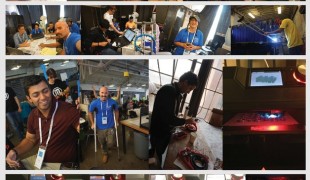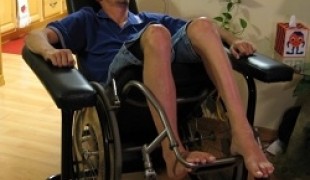- 4803
- 368
- 8
- 5
- 0
- Help Ukraine
About the solution
The wheelchair project, called HU-GO, is currently in its first version, though Riveros has noted that he continues to make modifications and improvements to its design. For instance, in its second iteration, Riveros hopes to be able to 3D print the wheels and/or hubs. In its current version, HU-GO consists of 3D printed parts, a plywood frame, support rods, big wheels (the smaller wheels are 3D printed), and hardware, which include nuts and bolts as well as zip ties.
By looking to his own previously used wheelchair and by analyzing and breaking down its design, Riveros was able to develop a basic design for his own 3D printed wheelchair. It also helped that during the Sydney Olympics in 2000, Riveros worked to assist handicapped people in getting around the Olympic park and received training on how to operate and use a wheelchair. This knowledge has aided him in designing a functional and usable wheelchair.
The most important aspect of Riveros’ HU-GO project is that he has made it with the hopes that it will eventually reach people who are not only disabled physically, but are marginalized within their societies, and even within the world. That is, the design for the 3D printed wheelchair came from a desire to help and provide necessary assistive technology to those who need it, regardless of their wealth or social standing. As he expresses on his Thingiverse page, “I strongly believe that everyone in the world deserves to be able to move about and a wheelchair should not be a luxury item for the few/well off. It should be a tool that anyone should have access to use.”
More info: http://www.hugoriveros.com/
Adapted from: http://bit.ly/1Lkc7fj
What about you, do you have any solutions? Please share them with the Patient Innovation community!
这些解决方案不应包括使用药物,化学品或生物制品(包括食品);创伤性设备;冒犯性的,商业或内在危险的内容。该解决方案未经医学验证。请谨慎进行!如果您有任何疑问,请咨询健康专家。
DISCLAIMER: This story was written by someone who is not the author of the solution, therefore please be advised that, although it was written with the utmost respect for the innovation and the innovator, there can be some incorrect statements. If you find any errors please contact the patient Innovation team via info@patient-innovation.com
-
-
702
-
1
-
13160

Carry Crutches – Cup holder for people who use crutches
WALKING WITH A WALKING AID: Walking with a walking aid
(SELF)-CARE: DRINKING: Drinking independently.
3d Printed
Walking Aid (wheelchair/walker/crutches)
Promoting self-management
Promoting inclusivity and social integration
Maintaining Balance and Mobility
Preventing (Vaccination, Protection, Falls, Research/Mapping)
Internal Medicine
Neurology
Orthopedics
Rheumatology
Solutions for Disabled people
United States
-
-
-
577
-
0
-
9540

Wheelchair Accessible Recliner
MOVING IN A WHEELCHAIR: Moving using a wheelchair.
CAREGIVING
Cervical spinal cord injury/Tetraplegia
Walking Aid (wheelchair/walker/crutches)
Managing pain
Promoting self-management
Preserving Organ Function
Promoting inclusivity and social integration
Maintaining Balance and Mobility
Restoring Blood Circulation
Preventing (Vaccination, Protection, Falls, Research/Mapping)
Internal Medicine
Neurology
Orthopedics
Rheumatology
United States
-
-
-
521
-
0
-
7455

Scooter for disabled people
MOVING IN A WHEELCHAIR: Moving using a wheelchair.
CAREGIVING
Amyotrophic Lateral Sclerosis
Assistive Daily Life Device (to help ADL)
Walking Aid (wheelchair/walker/crutches)
Gait abnormalities (e.g., walking difficulties, unsteady gait)
Muscle cramps or spasms
Difficulty coordinating movements
Stiffness or rigidity (difficulty moving)
Paralysis of the legs and lower body
Muscle weakness
Fatigue
Restoring mobility
Promoting self-management
Rehabilitating After Stroke
Managing Neurological Disorders
Promoting inclusivity and social integration
Preventing (Vaccination, Protection, Falls, Research/Mapping)
Caregiving Support
Neurology
Orthopedics
Rheumatology
United States
-
 zh
zh